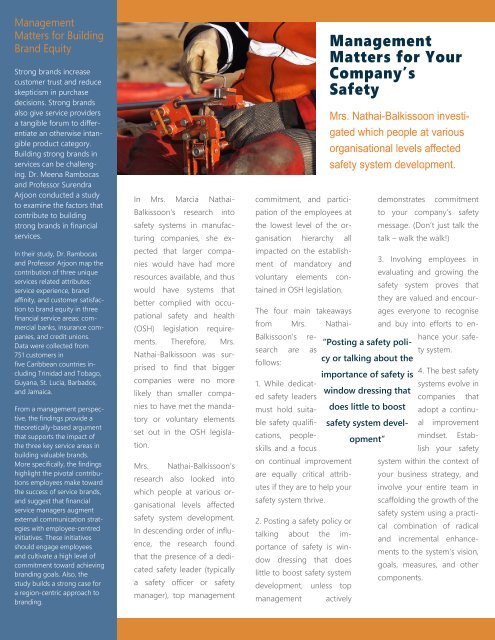DMS Newsletter Draft 2
Create successful ePaper yourself
Turn your PDF publications into a flip-book with our unique Google optimized e-Paper software.
Strong brands increase<br />
customer trust and reduce<br />
skepticism in purchase<br />
decisions. Strong brands<br />
also give service providers<br />
a tangible forum to differentiate<br />
an otherwise intangible<br />
product category.<br />
Building strong brands in<br />
services can be challenging.<br />
Dr. Meena Rambocas<br />
and Professor Surendra<br />
Arjoon conducted a study<br />
to examine the factors that<br />
contribute to building<br />
strong brands in financial<br />
services.<br />
In their study, Dr. Rambocas<br />
and Professor Arjoon map the<br />
contribution of three unique<br />
services related attributes:<br />
service experience, brand<br />
affinity, and customer satisfaction<br />
to brand equity in three<br />
financial service areas: commercial<br />
banks, insurance companies,<br />
and credit unions.<br />
Data were collected from<br />
751 customers in<br />
five Caribbean countries including<br />
Trinidad and Tobago,<br />
Guyana, St. Lucia, Barbados,<br />
and Jamaica.<br />
From a management perspective,<br />
the findings provide a<br />
theoretically-based argument<br />
that supports the impact of<br />
the three key service areas in<br />
building valuable brands.<br />
More specifically, the findings<br />
highlight the pivotal contributions<br />
employees make toward<br />
the success of service brands,<br />
and suggest that financial<br />
service managers augment<br />
external communication strategies<br />
with employee-centred<br />
initiatives. These initiatives<br />
should engage employees<br />
and cultivate a high level of<br />
commitment toward achieving<br />
branding goals. Also, the<br />
study builds a strong case for<br />
a region-centric approach to<br />
branding.<br />
In Mrs. Marcia Nathai-<br />
Balkissoon's research into<br />
safety systems in manufacturing<br />
companies, she expected<br />
that larger companies<br />
would have had more<br />
resources available, and thus<br />
would have systems that<br />
better complied with occupational<br />
safety and health<br />
(OSH) legislation requirements.<br />
Therefore, Mrs.<br />
Nathai-Balkissoon was surprised<br />
to find that bigger<br />
companies were no more<br />
likely than smaller companies<br />
to have met the mandatory<br />
or voluntary elements<br />
set out in the OSH legislation.<br />
Mrs. Nathai-Balkissoon’s<br />
research also looked into<br />
which people at various organisational<br />
levels affected<br />
safety system development.<br />
In descending order of influence,<br />
the research found<br />
that the presence of a dedicated<br />
safety leader (typically<br />
a safety officer or safety<br />
manager), top management<br />
Balkissoon’s research<br />
are as<br />
follows:<br />
1. While dedicated<br />
safety leaders<br />
must hold suitable<br />
safety qualifications,<br />
peopleskills<br />
and a focus<br />
commitment, and participation<br />
demonstrates commitment<br />
of the employees at<br />
the lowest level of the organisation<br />
to your company’s safety<br />
message. (Don’t just talk the<br />
hierarchy all talk – walk the walk!)<br />
impacted on the establishment<br />
of mandatory and<br />
3. Involving employees in<br />
voluntary elements contained<br />
evaluating and growing the<br />
in OSH legislation.<br />
safety system proves that<br />
they are valued and encourages<br />
The four main takeaways<br />
everyone to recognise<br />
from Mrs. Nathai- and buy into efforts to enhance<br />
your safety<br />
system.<br />
“Posting a safety policy<br />
or talking about the<br />
importance of safety is<br />
4. The best safety<br />
systems evolve in<br />
window dressing that<br />
companies that<br />
does little to boost adopt a continu-<br />
safety system developmental<br />
improvement<br />
mindset. Establish<br />
your safety<br />
on continual improvement<br />
are equally critical attributes<br />
if they are to help your<br />
safety system thrive.<br />
system within the context of<br />
your business strategy, and<br />
involve your entire team in<br />
scaffolding the growth of the<br />
safety system using a practical<br />
2. Posting a safety policy or<br />
combination of radical<br />
talking about the importance<br />
and incremental enhancements<br />
of safety is win-<br />
dow dressing that does<br />
little to boost safety system<br />
to the system’s vision,<br />
goals, measures, and other<br />
components.<br />
development, unless top<br />
management actively




